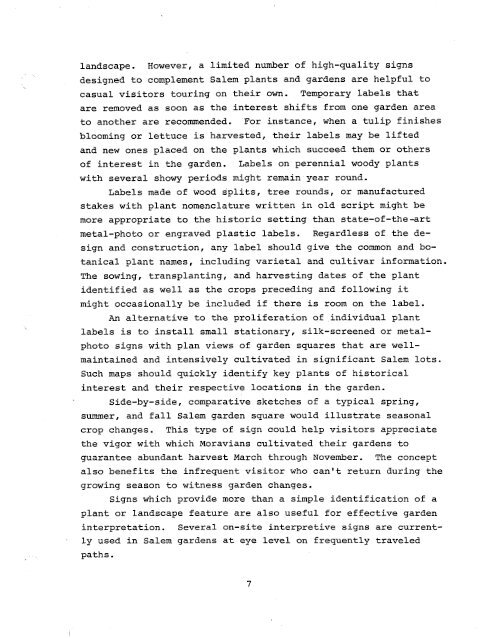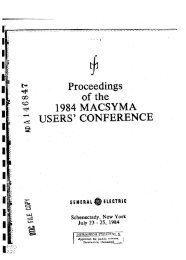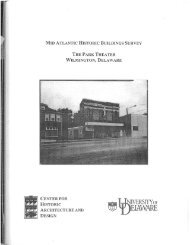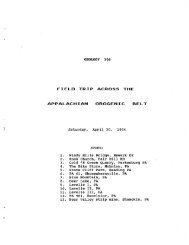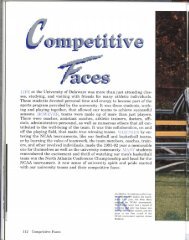Newark, DE 19711 - University of Delaware Library Institutional ...
Newark, DE 19711 - University of Delaware Library Institutional ...
Newark, DE 19711 - University of Delaware Library Institutional ...
Create successful ePaper yourself
Turn your PDF publications into a flip-book with our unique Google optimized e-Paper software.
landscape. However, a limited number <strong>of</strong> high-quality signs<br />
designed to complement Salem plants and gardens are helpful to<br />
casual visitors touring on their own. Temporary labels that<br />
are removed as soon as the interest shifts from one garden area<br />
to another are recommended. For instance, when a tulip finishes<br />
blooming or lettuce is harvested, their labels may be lifted<br />
and new ones placed on the plants which succeed them or others<br />
<strong>of</strong> interest in the garden. Labels on perennial woody plants<br />
with several showy periods might remain year round.<br />
Labels made <strong>of</strong> wood splits, tree rounds, or manufactured<br />
stakes with plant nomenclature written in old script might be<br />
more appropriate to the historic setting than state-<strong>of</strong>-the-art<br />
metal-photo or engraved plastic labels. Regardless <strong>of</strong> the de-<br />
sign and construction, any label should give the common and bo-<br />
tanical plant names, including varietal and cultivar information.<br />
The sowing, transplanting, and harvesting dates <strong>of</strong> the plant<br />
identified as well as the crops preceding and following it<br />
might occasionally be included if there is room on the label.<br />
An alternative to the proliferation <strong>of</strong> individual plant<br />
labels is to install small stationary, silk-screened or metal-<br />
photo signs with plan views <strong>of</strong> garden squares that are well-<br />
maintained and intensively cultivated in significant Salem lots.<br />
Such maps should quickly identify key plants <strong>of</strong> historical<br />
interest and their respective locations in the garden.<br />
Side-by-side, comparative sketches <strong>of</strong> a typical spring,<br />
summer, and fall Salem garden square would illustrate seasonal<br />
crop changes. This type <strong>of</strong> sign could help visitors appreciate<br />
the vigor with which Moravians cultivated their gardens to<br />
guarantee abundant harvest March through November. The concept<br />
also benefits the infrequent visitor who can't return during the<br />
growing season to witness garden changes.<br />
Signs which provide more than a simple identification <strong>of</strong> a<br />
plant or landscape feature are also useful for effective garden<br />
interpretation. Several on-site interpretive signs are current-<br />
ly used in Salem gardens at eye level on frequently traveled<br />
paths.<br />
7


